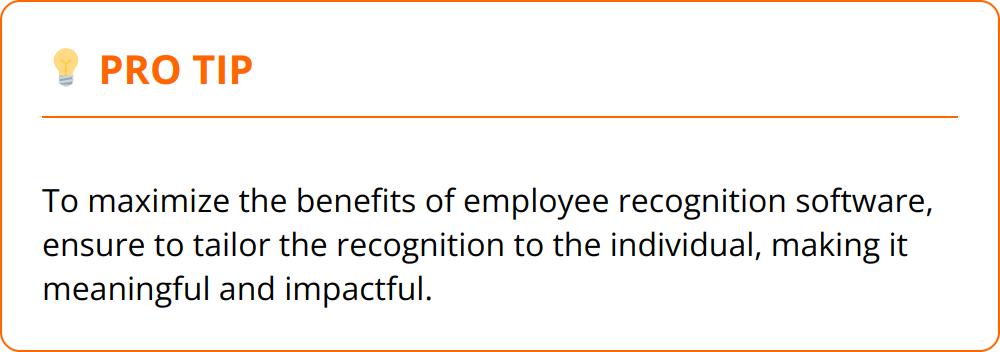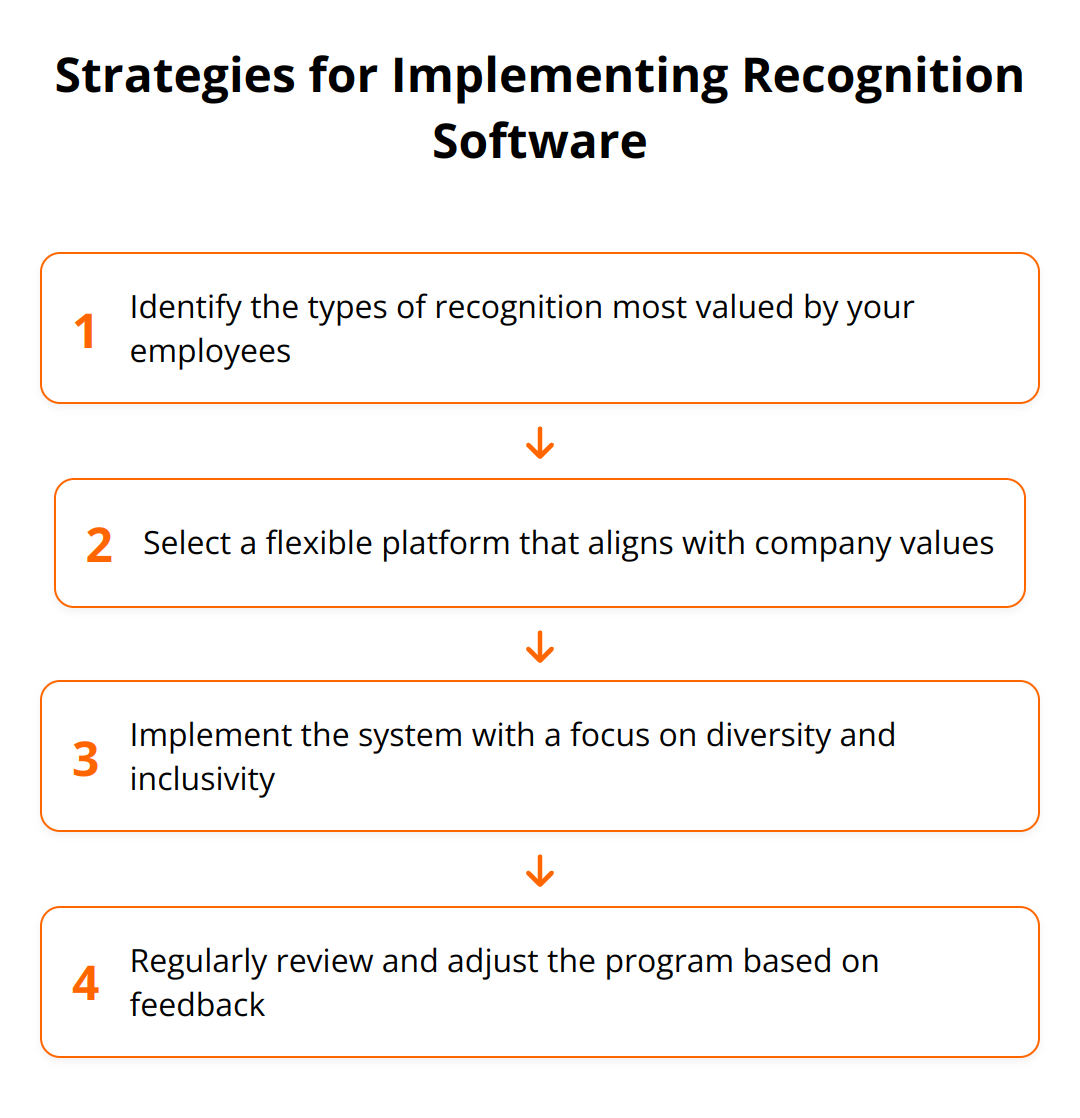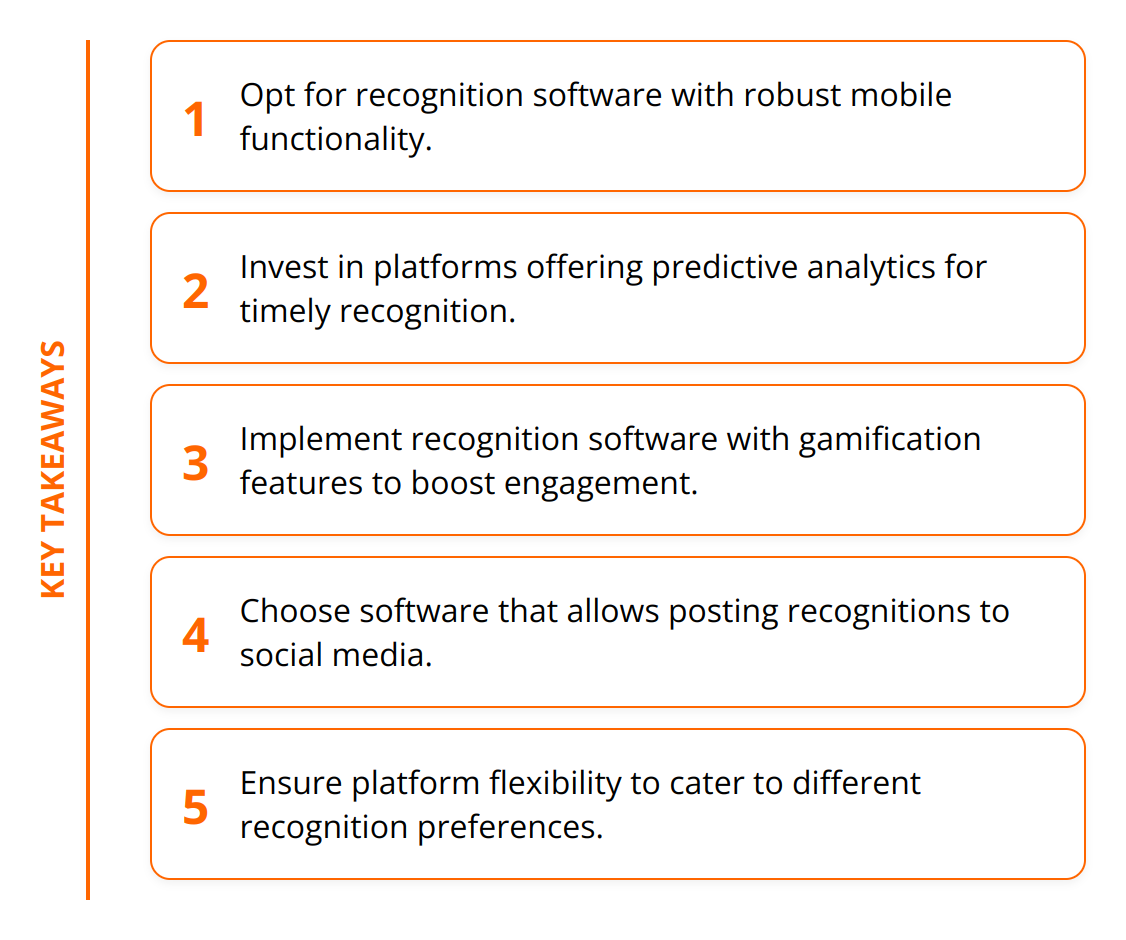
We at Reward the World have observed firsthand how rapidly the landscape of employee recognition is evolving. With the rise of remote work, the way we acknowledge and reward our team members needs to adapt. Innovations such as integrating with social media, leveraging artificial intelligence, and developing mobile functionalities are reshaping this space. This post: “What Trends Are Shaping Employee Recognition Software” explores these transformative trends and their influence on employee morale and organizational culture.
Shaping Trends in Employee Recognition
The landscape of employee recognition is undergoing significant transformation, driven by technological advances and changing workplace dynamics. Here, we delve into how these shifts impact the recognition practices that are vital for maintaining high morale and a strong organizational culture.
Remote Work Revolutionizing Recognition Practices
The rise of remote work has fundamentally altered how we think about employee recognition. Traditional, in-person recognition methods are often not feasible, creating a need for digital solutions that reach every team member, no matter where they work. It’s vital for organizations to adopt recognition software that is accessible and engaging for remote teams. This means prioritizing platforms with features such as mobile access, to ensure that recognition can happen anytime and anywhere, reflecting the flexibility remote work offers.
Practical tips:
- Opt for recognition software with robust mobile functionality.
- Regularly celebrate achievements in virtual team meetings.
- Utilize digital platforms for peer recognition across locations.

Social Media Integration Expands Recognition’s Reach
Integrating recognition software with social media platforms can amplify the effects of recognition by showcasing achievements on a wider stage. This not only boosts the morale of the recognized employee but also promotes a culture of recognition across the organization. Plus, it encourages others to aspire to high performance. Selecting software that can post recognitions to company social media accounts or platforms can turn recognition into a powerful tool for building employer brand and enhancing employee engagement.
Recommendations:
- Choose software that allows posting recognitions to social media.
- Ensure recognitions shared on social platforms adhere to company guidelines.
- Use social media to celebrate team achievements and work anniversaries.

AI Personalizes Recognition Efforts
Artificial Intelligence (AI) is not just a buzzword in the realm of employee recognition—it is a game-changer. AI technologies can analyze employee performance and preferences to tailor recognition in unprecedented ways. This can range from recommending the most appropriate form of recognition for a specific achievement to suggesting the best time for recognition to make the most impact. The key is to use AI to make recognition more meaningful and personalized, thereby increasing its effectiveness.
Key benefits:
- AI can help in crafting personalized recognition messages.
- Predictive analytics can identify the right moments for recognition.
- Customized rewards based on employee preferences enhance satisfaction.
In conclusion, embracing these trends requires thoughtful integration of technology with human-centric strategies. By doing so, organizations can create a recognition ecosystem that not only adapts to the contemporary work environment but also drives engagement, performance, and loyalty.
For further insights on elevating your recognition strategy, explore our resources on employee recognition ideas and incentive program personalization techniques.
Elevating Workforce Morale
Employee recognition software is transforming the workplace by fostering an environment where appreciation and acknowledgment are part of the daily routine. The impact on employee engagement, company culture, and turnover rates is significant, driving businesses to rethink their recognition strategies.

Employee recognition software serves as a critical tool in boosting employee engagement. Engaged employees are not just happier; they are also more productive, creative, and committed to their organization’s goals. Practical steps like recognizing contributions in real time and offering personalized rewards are straightforward yet effective in keeping the workforce motivated and engaged. For instance, when employees receive acknowledgment for their hard work immediately, it reinforces positive behavior, encouraging them and others to strive for excellence.
Moreover, these digital platforms play a vital role in enhancing company culture. A culture that values recognition is one where employees feel valued and part of a larger purpose. Implementing a system that allows for frequent, timely, and diverse forms of recognition, including peer-to-peer acknowledgments, integrates a culture of appreciation deep within the workplace fabric. This can lead to stronger relationships among colleagues, greater transparency, and an overall more positive work environment.
Furthermore, the implementation of recognition software is instrumental in reducing employee turnover rates. The lack of appreciation is a common reason for employees to leave their jobs. By making recognition a regular part of the workplace, companies can significantly decrease turnover. Data shows that organizations with strong recognition programs have up to 31% lower voluntary turnover rates than those without. This not only saves costs associated with hiring and onboarding but also preserves organizational knowledge and boosts overall morale.

To achieve these benefits, it’s essential to select a recognition platform that is flexible, inclusive, and aligns with your organization’s values and objectives. Here are a few actionable tips:
- Ensure the platform offers a mix of recognition types, catering to different preferences and achievements.
- Look for features that support instant recognition and social sharing to extend the impact.
- Analyze data provided by the software to understand recognition patterns and improve your strategy over time.
Employee recognition software is not just a trend; it’s becoming a cornerstone of effective human resource strategies. By focusing on the practical application of these tools, organizations can create a more engaged, motivated, and loyal workforce.
Explore more on employee recognition ideas and how to enhance your strategy.
Future Trends in Recognition Software
As we continue to navigate the evolving landscape of the workplace, staying ahead of the curve in employee recognition practices is more important than ever. The future of recognition software is set to bring even more dynamic changes, focusing on personalization, accessibility, and engagement. Here we dissect the significant developments expected to shape the future of recognition software, offering practical insights on how to leverage these trends for organizational advantage.
Harnessing Predictive Analytics for Timely Recognition
Predictive analytics represents a revolutionary shift in employee recognition strategies. By analyzing vast amounts of data, including performance metrics and recognition patterns, predictive analytics can forecast the optimal times for recognizing employees. This technology enables managers to act proactively, offering praise or rewards at moments when it will have the most impact on morale and productivity. Organizations that adapt to this trend can expect a noticeable boost in employee satisfaction and retention rates.
Practical Tips:
- Invest in recognition platforms that offer predictive analytics features.
- Regularly review the insights provided by analytics to fine-tune recognition timing.
- Train managers on interpreting predictive data to improve their recognition efforts.
Mobile Functionality Enhances Recognition Accessibility
In today’s mobile-centric world, recognition software must be as accessible and convenient as possible. Enhanced mobile functionality allows employees to receive and give recognition on the go, fitting seamlessly into the busy schedules of modern workers. This level of accessibility ensures that no achievement goes unnoticed and fosters a continuous culture of appreciation. Features such as push notifications and mobile-friendly interfaces are becoming non-negotiable for effective recognition platforms.
Actionable Insights:
- Choose platforms with intuitive mobile apps.
- Encourage employees to engage with the recognition program through their mobile devices.
- Utilize mobile alerts to remind employees of recognition opportunities.
Gamification Drives User Engagement
Gamification in recognition software is not just about making the process fun; it’s a strategic approach to increasing user engagement. By introducing elements like points, badges, and leaderboards, recognition becomes a more interactive and competitive experience. This not only encourages participation but also makes the act of recognition more appealing and memorable. Employees who engage with gamified elements are more likely to feel valued and motivated, significantly impacting overall job satisfaction.
Strategies for Implementation:
- Implement recognition software that incorporates gamification features.
- Create competitions or challenges around recognition activities.
- Celebrate milestones achieved within the gamification system to highlight its importance.
Incorporating these future developments into your employee recognition software strategy can significantly enhance the effectiveness of your efforts. By focusing on predictive analytics, mobile accessibility, and gamification, organizations can create a more engaging, timely, and meaningful recognition experience for their employees.
For more on creating an effective recognition strategy, check out our guide on personlizing reward programs and tips on incentive analytics.
Wrapping Up
Throughout this exploration of the latest trends in employee recognition software, we’ve highlighted the game-changing role that technology plays. The rise of remote work, social media integration, and artificial intelligence has supported a revolution in how businesses recognize and reward their employees. Each of these elements—whether it’s making recognition accessible to remote teams, amplifying achievements across social platforms, or personalizing rewards through AI—contributes to a more engaged, motivated, and satisfied workforce.

The key takeaway is clear: Adapting to these technological changes isn’t just beneficial; it’s essential for organizations looking to thrive in today’s dynamic workplace environment. By leveraging advanced recognition tools, businesses can foster a culture of appreciation that resonates deeply with employees, driving performance and loyalty.
In this rapidly evolving landscape, investing in sophisticated recognition software is more than a strategic move—it’s a vital step towards optimizing workforce morale and productivity. Companies that embrace these tools not only stand out as employers of choice but also build stronger, more cohesive teams ready to tackle the challenges and opportunities of the future.
We at Reward the World encourage businesses to explore how our global incentives platform can elevate their employee recognition programs. With our extensive experience in delivering instant, varied, and personalized rewards, we’re here to help you harness the full potential of these emerging trends, ensuring your recognition strategy remains robust, relevant, and effective.
In conclusion, staying ahead in employee recognition means embracing the technological wave, and we’re excited to pave the way.
